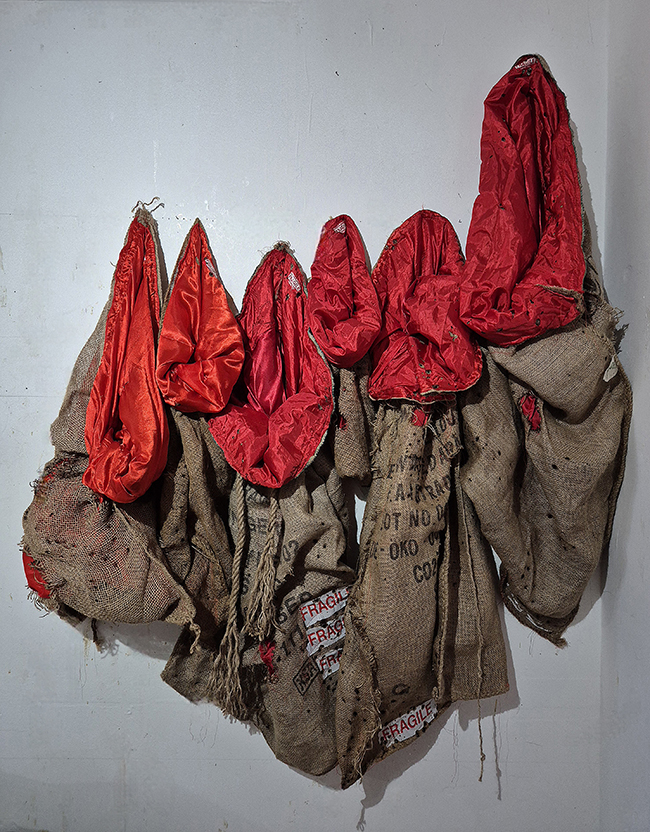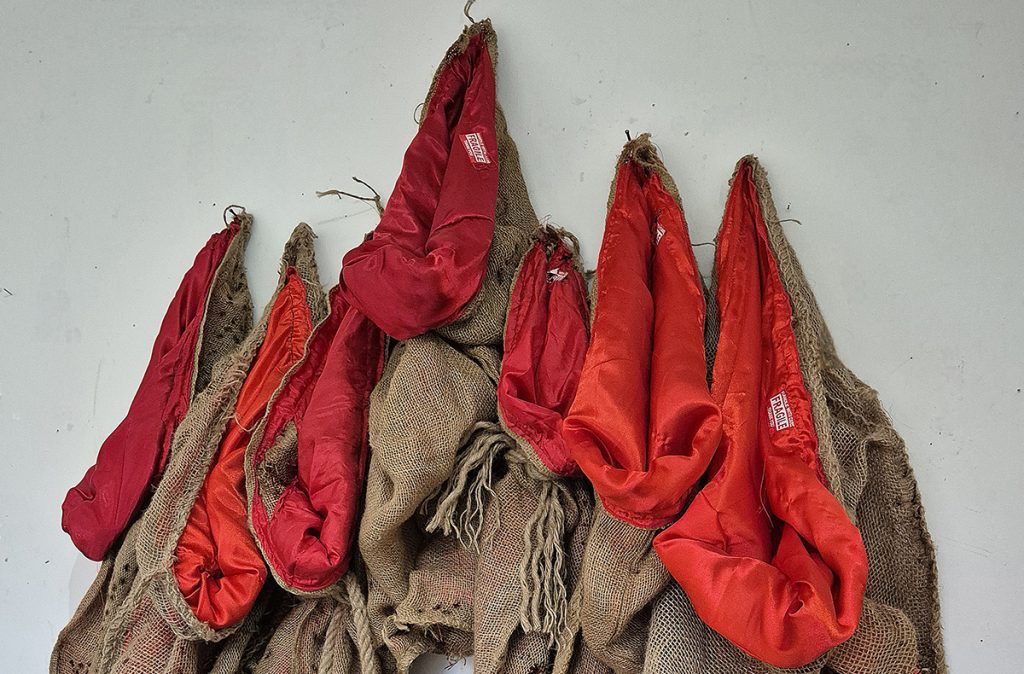Bea Last, a Scottish artist, weaves a narrative of raw beauty and profound meaning through her unique creative practice. Currently based in the picturesque landscapes of Scotland, Last’s work is a testament to her dedication to process and her ability to transform recycled, repurposed, found, salvaged, or gifted materials into what she eloquently calls “sculptural drawing.” Her work is not just about form but about resonance. Objects that might otherwise be discarded or overlooked find a new life in her hands, gaining both texture and significance. Through this method, she gives shape to memory, fragility, and resilience. Her art moves fluidly between individual works and larger installations, each piece contributing to a conversation about humanity, survival, and transformation.

The Work: The One Hundred and Twenty Four
At the center of Bea Last’s current practice is an ambitious installation in progress: The One Hundred and Twenty Four. It consists of 124 sacks, each crafted from materials with their own histories and vulnerabilities—hessian, satin, rope, fragile labels, even the marks of fire and bullet holes. Each sack can be viewed as an individual sculpture or in smaller groupings, but together they form a larger whole that is both haunting and monumental.
The piece is rooted in a harrowing statistic. Verified reports confirm that by 2024/25 there were 124 armed conflicts unfolding around the world at the same time. Only a year earlier, the number stood at 54. In this escalation, Last found both the title and the structure of her work. Each sack stands for a conflict. Each sack, in turn, becomes a vessel of loss, destruction, and memory.
Her method brings a tactile immediacy to something that otherwise might remain an abstract number on a report. The stitched seams, the scorched fabric, the bullet holes—all carry the weight of violence and trauma in material form. The fragile labels are more than props; they remind us of how precarious human existence becomes when war and displacement take hold.
Material as Witness
Last’s practice has long relied on found and salvaged objects. In this project, the choice of materials feels especially apt. Hessian is rough, common, and cheap—a fabric of sacks and shelters, tied to displacement and poverty. Satin, by contrast, speaks to fragility and luxury, a surface easily torn. Fire leaves its trace as both destructive force and accidental mark. Rope binds, restrains, or supports. Bullet holes tear through, a violent interruption that can never be undone.
By combining these elements, Last forces us to look at war through texture, weight, and scar. Instead of an image of a battlefield or a news photograph, we encounter the residue of conflict in forms that demand physical presence. Her “sculptural drawings” are not fixed illustrations but ongoing marks—gestures of confrontation and remembrance.
Context and Continuity
Although The One Hundred and Twenty Four is still a work in progress, its concept resonates with the long sweep of human history. Last reminds us that armed conflict is not only about contemporary crises but part of a recurring cycle: genocide, displacement, starvation, mass movement, slavery, ethnic cleansing, tyranny, and the weaponization of sexual violence. These are not new, nor are they limited to one region or era. Her installation situates today’s numbers within a continuum of destruction and survival.
In doing so, she also underlines the persistence of trauma—both immediate and generational. Wars end, but their aftershocks ripple across families, cultures, and landscapes for decades. The sacks, standing in silent rows, echo this unending repetition. They feel archival yet current, timeless yet painfully now.
A Studio of Witness
Through her posts and process notes, Last invites others into her studio as she builds this massive body of work. Each sack becomes a detail, a marker, a reminder. The repetition of labor—sewing, cutting, burning, labeling—becomes part of the ritual. This ritual mirrors the cycles of conflict: another stitch, another scar, another tally added to the total.
What makes her approach compelling is its refusal to look away. The numbers could numb us, but her materials refuse to let that happen. They speak in textures, in the evidence of the hand, in the visible transformation of fabric and rope. Her work does not simply illustrate conflict; it embodies its weight.
Toward Installation
When completed, The One Hundred and Twenty Four will not only occupy space but also envelop it. Viewers will move among the sacks, confronted with the sheer scale of simultaneous human suffering. The installation will force a reckoning with statistics that might otherwise dissolve into abstraction. It will remind us that each conflict involves bodies, lives, and futures—none of them reducible to numbers alone.
Bea Last’s “sculptural drawings” make us stop and consider the violence etched into history and the present alike. Her work is both art and testimony. It asks us not only to witness but to carry forward the awareness that conflict continues, and that its scars—like the bullet holes and burns in her materials—do not fade.

